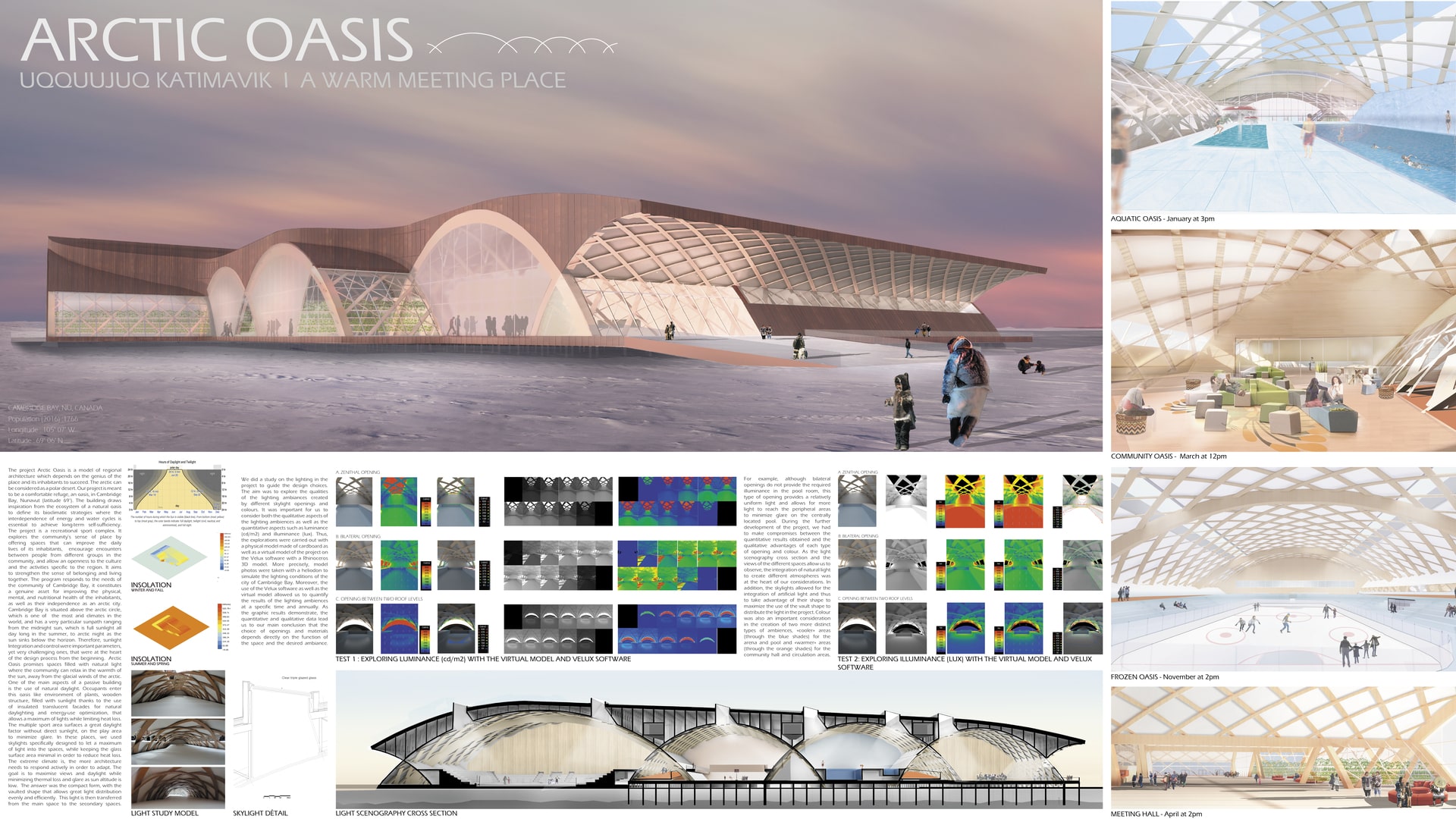Project Description
The project Arctic Oasis is a model of regional architecture which depends on the genius of the place and its inhabitants to succeed. The arctic can be considered as a polar desert. Our project is meant to be a comfortable refuge, an oasis, in Cambridge Bay, Nunavut (latitude 69°). The building draws inspiration from the ecosystem of a natural oasis to define its bioclimatic strategies where the interdependence of energy and water cycles is essential to achieve long-term self-sufficiency. The project is a recreational sport complex. It explores the community’s sense of place by offering spaces that can improve the daily lives of its inhabitants, encourage encounters between people from different groups in the community, and allow an openness to the culture and the activities specific to the region. It aims to strengthen the sense of belonging and living together. The program responds to the needs of the community of Cambridge Bay, it constitutes a genuine asset for improving the physical, mental, and nutritional health of the inhabitants, as well as their independence as an arctic city. Cambridge Bay is situated above the arctic circle, which is one of the most arid climates in the world, and has a very particular sunpath ranging from the midnight sun, which is full sunlight all day long in the summer, to arctic night as the sun sinks below the horizon. Therefore, sunlight Integration and control were important parameters, yet very challenging ones, that were at the heart of the design process from the beginning. Arctic Oasis promises spaces filled with natural light where the community can relax in the warmth of the sun, away from the glacial winds of the arctic. One of the main aspects of a passive building is the use of natural daylight. Occupants enter this oasis like environment of plants, wooden structure, filled with sunlight thanks to the use of insulated translucent facades for natural daylighting and energy-use optimization, that allows a maximum of lights while limiting heat loss. The multiple sport area surfaces a great daylight factor without direct sunlight, on the play area to minimize glare. In these places, we used skylights specifically designed to let a maximum of light into the spaces, while keeping the glass surface area minimal in order to reduce heat loss. The extreme climate is, the more architecture needs to respond actively in order to adapt. The goal is to maximize views and daylight while minimizing thermal loss and glare as sun altitude is low. The answer was the compact form, with the vaulted shape that allows great light distribution evenly and efficiently. This light is then transferred from the main space to the secondary spaces. We did a study on the lighting in the project to guide the design choices. The aim was to explore the qualities of the lighting ambiances created by different skylight openings and colours. It was important for us to consider both the qualitative aspects of the lighting ambiences as well as the quantitative aspects such as luminance (cd/m2) and illuminance (lux). Thus, the explorations were carried out with a physical model made of cardboard as well as a virtual model of the project on the Velux software with a Rhinoceros 3D model. More precisely, model photos were taken with a heliodon to simulate the lighting conditions of the city of Cambridge Bay. Moreover, the use of the Velux software as well as the virtual model allowed us to quantify the results of the lighting ambiences at a specific time and annually. As the graphic results demonstrate, the quantitative and qualitative data lead us to our main conclusion that the choice of openings and materials depends directly on the function of the space and the desired ambiance. For example, although bilateral openings do not provide the required illuminance in the pool room, this type of opening provides a relatively uniform light and allows for more light to reach the peripheral areas to minimize glare on the centrally located pool. During the further development of the project, we had to make compromises between the quantitative results obtained and the qualitative advantages of each type of opening and colour. As the light scenography cross section and the views of the different spaces allow us to observe, the integration of natural light to create different atmospheres was at the heart of our considerations. In addition, the skylights allowed for the integration of artificial light and thus to take advantage of their shape to maximize the use of the vault shape to distribute the light in the project. Colour was also an important consideration in the creation of two more distinct types of ambiances, "cooler" areas (through the blue shades) for the arena and pool and "warmer" areas (through the orange shades) for the community hall and circulation areas.
